|
< Earlier Kibitzing · PAGE 2 OF 2 ·
Later Kibitzing> |
May-18-16
 | | al wazir: My analysis of 24. Qa7+ Kc7 25. Nc6 Ra8 is wrong: 26. Qb6+ is answered by 26...Nxb6. But after 26. Qd4 bxa6 27. Qxc4, white still has a strong position, threatening 28. Nxe7+ and 28. Ne5+. |
|
| May-18-16 | | AlicesKnight: 24.Nc6+ looks possible - there is no K move or P capture so Rxc6; 25.Qa7+. If 25.... Kc7 then 26.Rxc6+ Kd8; 26.Qb8+ and mate to follow, while if 25....Kc8 then dxc6 forcing recapture by the P which frees the White R and gives time for Qa8+ winning the other R at least ..... let's see - close enough. Black's 19th and 20th moves amounted to a waste of time while White set up the heavy pieces. |
|
| May-18-16 | | Olsonist: What about Nb5 as an alternate solution? With the threat of the Ra8 sac/mate black has to drop his queen. |
|
| May-18-16 | | ndg2: I also opted for Nb5. Black has to give a whole queen for just a knight. |
|
| May-18-16 | | patzer2: Impressive play from a young Ray Robson in the World U-12 Championship. For an early opening improvement for Black, I prefer the popular move 7...Be7 = (0.17 @ 37 depth, Komodo 9.42) as in Nakamura vs A Giri, 2016. The strong move which gives white a decisive advantage is 19. Ra3!  (+1.97 @ 17 depth, Deep Fritz 15). (+1.97 @ 17 depth, Deep Fritz 15). |
|
| May-18-16 | | nisharaj31: Nb5 does not work as the white queen is en prise |
|
| May-18-16 | | Modulo: White to play, 24. ?
It seems like there is a mate somewhere, but since I can't find it I'll go with 24. Nc6+ Rxc6
25. Qa7+ Kc8
26. dxc6
winning the exchange while maintaining a good attack. |
|
| May-18-16 | | whiteshark: Black's final 4 ♘ moves starting with <19...Ne4> looked quite unfavourable. |
|
| May-18-16 | | morfishine: Checking-checks, that is (1) 24.Qa7+> & (2) 24.Nc6+ leaves <24.Nc6+> as the best check ***** |
|
| May-18-16 | | schachfuchs: I don't understand black's 19....Ne4 20.Qb4 Nc5 21.Bxa6.
Couldn't black get any other couterplay? |
|
May-18-16
 | | Willber G: <Olsonist: What about Nb5 as an alternate solution?> <ndg2: I also opted for Nb5.> 24...NxQ |
|
| May-18-16 | | gofer: I "found" this one, but also found it very difficult, not <Medium Easy> at all... <24 Nc6+ Rxc6+>
<25 Qa7+ ...>
25 ... Kc7
26 Rxc6+ Qxc6 (Kd8 27 Qa8+ Qc8 28 Qxc8#)
27 dxc6 
<25 ... Kc8>
Okay, we can play the following line as <agb2002> points out... 26 Qa8+ Kc7
27 Rxc6+ bxc6
28 Qxh8 Qg4!
...but I found defending the position a little too tricky, so instead
wanted to play...
<26 dxc6! ...>

click for larger view26 ... bxa6?
27 Qxd7+ Kb8
28 Qb7#
26 ... bxc6
27 b3! 
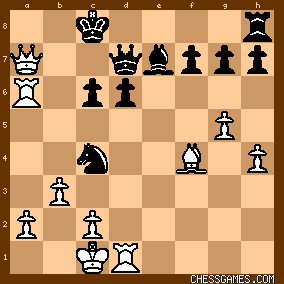
click for larger viewWhite's position is overwhelming... ...the worst option is the "obvious" move... 27 ... Ne5
28 Qa8+ Kc7
29 Ra7+ Kb6
30 Be3+ mating!
and all other ones seem to leave black a whole rook down or worse! <26 ... Qc7>
<27 Rd4! ...>
This may not be the most material gain for white, but it sets up a very clear
positional advantage that Black is doomed to fail from here on... 27 ... bxc6
28 Rxc4 
27 ... Nb6
28 Rxb6 
27 ... Ne5
28 Bxe5 dxe5
29 Rd7 
<27 ... bxa6>
<28 Qxa6+ Kd8>
<29 Rxc4  > >

click for larger viewAll black moves lead to death... |
|
| May-18-16 | | CHESSTTCAMPS: In this middle-game attacking position, white's pin of the b-pawn keys a strong attack against a weakened queen-side castled position. It seems a reasonable assumption that white has already exploited the pin by grabbing a pawn at a6, provoking a clever, but inadequate counter-attack 23... Nc4 to try to shift the pinning queen. But white holds the important cards and can cash in with: 24.Nc6+! leaving black only 2 legal moves that both lose. A. 24... Qxc6 25.Qa7+ Kc7 26.Rxc6+ Kd7 (Kd8 27.Rxc8+ Kxc8 28.Qa8+) 27.Qxb7+ is a slaughter. B. 24... Rxc6 25.Qa7+ Kc8 (Kc7 26.Rxc6+ Qxc6 [26... Kd8 27.Qa8+ forces mate] 27.dxc6 wins) 26.dxc6 Qc7 27.Qxb7+ Qxb7 28.cxb7+ Kxb7 29.Ra4 nets white an exchange plus several pawns. Time for review.... |
|
| May-18-16 | | Ayaend: <al wazir> Yes I wanted to tell you at your line is wrong but you saw it and have corrected ^^ but anyway White is clearly better. |
|
| May-18-16 | | mel gibson: The first move is easy - then it takes a lot of thought to finish the game off. |
|
| May-18-16 | | thegoodanarchist: White gave Harsha treatment to Black's king. |
|
May-18-16
 | | Jimfromprovidence: I had the same line as <gofer> 24 Nc6+ Rxc6+ 25 Qa7+ Kc8 26 dxc6 Qc7, but then diverged with 27 Qa8+ Qb8 28 cxb7+ Kc7.
click for larger viewThen I thought of 29 b3!?

click for larger view One response is 29...Nb6 30 Re1 (seeing 31 Rxe7). |
|
| May-18-16 | | kevin86: The crucial pin of the b-pawn will win black's queen. |
|
| May-18-16 | | dumbgai: Well, I feel stupid for going with Nb5, not noticing that white would lose the queen! |
|
May-18-16
 | | gawain: Alas! Like a few others I (suffering from chess blindness)thought 24 Nb5 would win. Oops. I liked 24... Rc7 (or Rc5) 25 Ra8+ Kxa8 26 Qa7# |
|
| May-18-16 | | YouRang: Well, I started with <24.Qa7+> (following the "monkey see check, monkey do check" principle). This gets my Q out of danger from Nc4 and forces <24.Kc7>. Now, I can kick that Nc4 with <25.b3>.
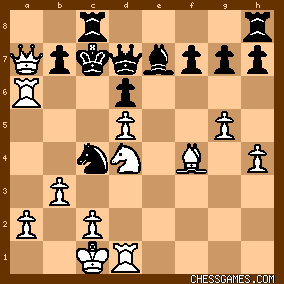
click for larger view
Black's only move to save his knight is <25...Ne5>, but this allows my Q to return to b6 with check, forcing the K back to b8: <26.Qb6+ Kb8>
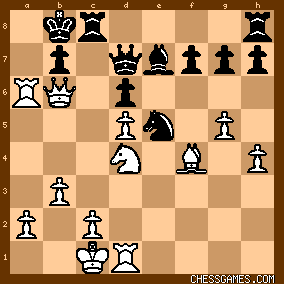
click for larger view
This is essentially the same position we started with except my Q is out of danger, so I have time to play the killer: <27.Nb5!>, which seals off c7, thus threatening Qa7#.

click for larger view
Black pretty much has to trade his Q for my Nb5, which pretty much leads to an entertaining endgame (spoiled only by the likely resignation of black). So what that 24.Nc6+ is a bit faster? Wins should be savored. :-) |
|
| May-18-16 | | dumbgai: <YouRang> What about 25...Kd8, which threatens ...bxa6? |
|
| May-18-16 | | YouRang: <dumbgai: <YouRang> What about 25...Kd8, which threatens ...bxa6?> Yeah, that's probably black's best, but even so white can get the R out of danger with <26.Ra4>, which seems to force <26...Ne5>
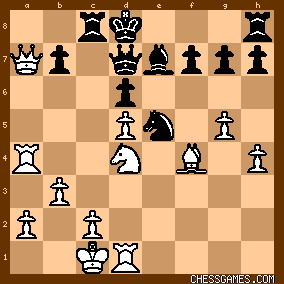
click for larger view
White has a pretty tactic here:
<27.Bxc5> removes defender of c6 <27...dxe5> recaptures, but also opens the d-file... <28.Nc6+!>
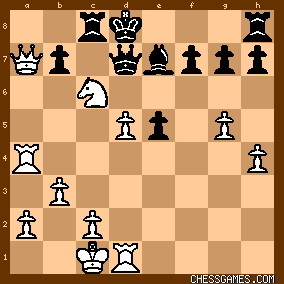
click for larger view
If 28...bxc6?, then 29.dxc6 exposes the rook pin on black's Q+K. So, we play <28...Ke8 29.Nxe6> (win another P and attack Q)
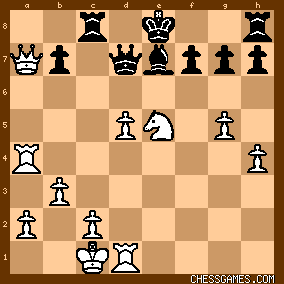
click for larger view
Okay, maybe not a slam dunk, but white is up 2P and has a vicious attack underway with all pieces active and rangy, along with the passed Pd5. Meanwhile, black's house is on fire, his Rh8 sits there like a worthless stump, and his Be7 isn't being real helpful either. I'm not too ashamed to call it a white win. |
|
| May-18-16 | | stst: The Black K is tightly trapped, but if the White Q checks first, after Kc7, White has no follow-up threats.
So let the N go first:
24.Nc6+ RxN (if ... QxN, after Qa7+, K moves, dxQ and Black lost the Q without compensation.)
25.Qa7+ Kc7/c8
26.RxR+ Kd8
27.Qa8+ Qc8 (hopelessly delaying only one move)
28.QxQ#
see if anything is over-looked. |
|
| May-18-16 | | stst: < I had the same line as <gofer> 24 Nc6+ Rxc6+ 25 Qa7+ Kc8 26 dxc6 Qc7,...> Here,
26.dxc6 taking the Black R is too anxious, it is soft, and does not threaten anything... Much better is
26.RxR+ utilizing the Qa7 position, and forces either a K move (trying to escape,) or, a Q-intervene: Qc7 where the White R takes, winning both R & Q. |
|
 |
|
< Earlier Kibitzing · PAGE 2 OF 2 ·
Later Kibitzing> |





